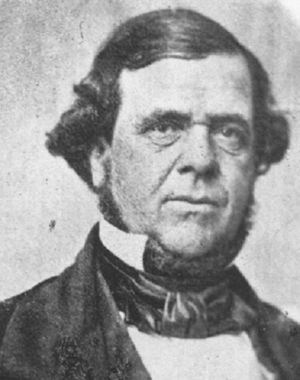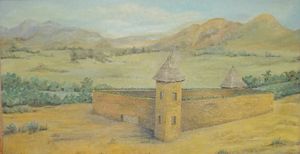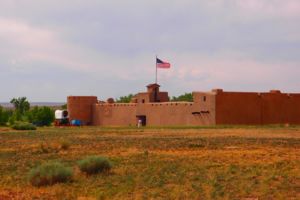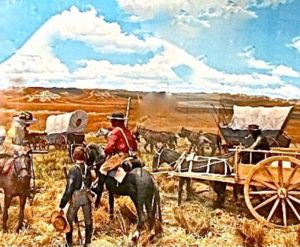Biography
Enlisted: Aug 13, 1861
Side: USA
Regiment(s): 1st Regiment, New Mexico Infantry (Old)
Ceran de Hault de Lassus de St. Vrain was the fourth son in a large family. His father was of French nobility and forced to escape to the new world before the French Revolution got out of hand. His mother was born in St. Louis, in what was then called New France or the Louisiana Territory. Ceran was born in 1802 in French territory along the Mississippi River one year before the United States made the Louisiana Purchase from the French. He was one of ten children by Jacques Marcellin Ceran de Hault de Lassus de Saint Vrain and Marie Felicite Chauvet Dubreuil. Ceran’s parents were able to send him and their other children to be educated in a private school, but with the death of his father, Ceran’s formal education was cut short in 1815. His mother, with such a large family, had to rely on friends to help raise them. Ceran stayed in General Bernard Pratte’s household until his coming of age.
In his early adulthood Ceran St. Vrain must have determined his fortunes laid to the west and so that’s where he went. He partnered up with other men more than once and ventured out trapping. He married his first wife, Maria Delores Del Luna, the daughter of Ana Maria Tafoya and Rafae Antonio Luna, in 1826. She was but 15 years old. By May, 1827, Ceran’s first son, Jose Vincente, was born in Taos, New Mexico, where Ceran’s wife’s family lived. Ceran and Maria were soon either divorced or separated as she married another man in 1828.
After two more trapping expeditions, one with horrible results and the loss of a dear friend, and the second being a great success, Ceran became interested in the trading business. On February 15, 1831, Ceran became a naturalized citizen of New Mexico. He continued to deal in furs, particularly beaver. He made an arrangement with Charles Bent to begin selling supplies, and by 1832 the pair had formed the company known as Bent & St. Vrain which dealt in merchandise, but mostly in furs. At the time they formed their partnership, Ceran and Charles had one store. By 1834 the company had erected a stockade fort called Fort Williams, better known as Bent’s Fort. In the years that followed, Ceran spent time trading with the Indians of the area as well as establishing Fort Saint Vrain in 1837 and Bent’s Fort in 1842, both in what is now Colorado.
Years after the separation from his first wife, Ceran took his second wife in around 1841. Her name was Maria Ygnacia Trujillo of Taos. She was the daughter of Antonio Jose and Manuela (Coca) Trujillo. They had the following four children:
Mathias Trujillo St. Vrain (1842- )
Jose Felix St. Vrain (1844–1886)
Maria Ysabel Trujillo (St. Vrain) Gomez (1846–1900)
Marcelino Trujillo St. Vrain (1847–1940)
In 1843, Ceran and a group of partners petitioned New Mexico’s Governor Armijo for a huge tract of land in southern Colorado and won approval. Known as the Las Animas Grant, it was about four million acres of land that these commercial and political figures from Taos wanted to control. Eventually Charles Bent would become involved as well.
When the Mexican-American War began Ceran left the area and stayed in St. Louis for a period of time. When the virtually bloodless war in New Mexico had ended, Ceran’s partner Charles Bent had been named the first American Governor of the Territory of New Mexico.
In January of 1847 a revolt that was thought to be instigated by the Catholic Priest of Taos, Antonio José Martínez, was staged by Mexicans and Pueblo Indians. This led to the scalping alive and eventual murder of Ceran St. Vrain’s business partner and close friend, Governor Charles Bent in front of his family. Along with Bent several other officials and citizens were murdered. Ceran was incensed. He gathered a force of 68 mounted men composed of mountain men from both sides of the border and joined the winter march of Colonel Sterling Price to retake Taos. Ceran’s force was called the ‘Avengers’ and Ceran was elevated to the rank of Captain. The force was successful in putting down the rebellion in Taos and it is said Ceran personally shot rebel leader Pablo Chavez. In turn, Ceran’s life was saved by one of his volunteers, a New Mexican man named Manuel Chaves. A rebel attacked St. Vrain and Chaves struck him with the butt of his rifle. In the aftermath, Ceran stayed in Taos to act as an interpreter during the trials held for the rebels who had been captured. Of the captured rebels 15 were convicted of treason and sentenced to death, they were executed in April of 1847.
Once American control of New Mexico was secured, Ceran’s personal wealth began to swell. He made money supplying the US Military with food and supplies and then the Bent & St. Vrain Company acknowledged a junior partner in Charles’ younger brother, William Bent. The company established another store in Santa Fe in 1847, but almost immediately Ceran sold his entire stock to Judge Joab Houghton and J.W. Folger. By 1850 he had also discontinued his partnership with William Bent.
On the 1850 census in Santa Fe, Santa Fe, New Mexico Territory at the age of: 48, his Birth Year (Estimated): 1802 and he gave his Birthplace: Missouri. The House Number: 1206, LISTED as Head of Household is Ceran St Vrain, Merchant, next is Vincent St. Vrain, M 23 New Mexico - Clerk , it is not stated who this St.Vrain is, but he appears to be a son. Listed next is Laac McCarty--M 38 Missouri, and then Wm. McCarty M--27 Ireland, next Charles Adams-M 35 Germany, then Rafael Alarid--M--16 New Mexico, last Lucian Stewart--M--31 Vermont [1]
St. Vrain then began selling off some of his land grant property. It’s estimated that some of the land became Canon City and Denver City in Colorado.
Among his many investments, Ceran had saw mills, he attempted to raise interest in the railroad projects, he also attempted to incorporate the First National Bank of New Mexico without success. By 1855 he had moved to Mora, New Mexico and made his home there. He erected the first grist mill in Mora and increased his fortune selling grain and flour to the US Military. Next Ceran expanded into publishing, establishing the Santa Fe Gazette. By 1858 he was designated the public printer of the territory. In 1860 he joined the Bent Lodge of Masons when it was founded in Mora.
Ceran was also appointed Lieutenant Colonel in the New Mexico Mounted Volunteers and charged with recruiting troops to quell the native rebellions under Colonel F.F. Fauntleroy. He maintained his position for the beginning months of the Civil War, and was commissioned as Colonel of the First New Mexican Calvary, but resigned his commission in September of 1861 in favor of his good friend Kit Carson.
His final and third marriage was to the former Louisa Branch in the early 1860s. They had one daughter, Felicitas (St. Vrain) Gallegos, born in 1862.
Ceran died on October 28, 1870 after suffering a stroke at the home of his son Vincente in Mora and died at the age of 68. His funeral that was held two days later was attended by over 2000 people including officers and troops from Fort Union. He was buried by the Masons with full military honors in his family plo, Saint Vrain Cemetery, Mora, New Mexico.
Today the name St. Vrain is memorialized across Colorado and New Mexico.
NOTE: There is a discrepancy concerning how many wives Ceran St. Vrain actually had. Some historians believe he had three wives while others say four based upon various records. I found sources that state he had four wives but don't offer evidence.
Sources
- ↑ Household ID: 1211--Line Number: 34--Affiliate Name: The U.S. National Archives and Records Administration (NARA)--Affiliate Publication Number: M432--Affiliate Film Number: 469--GS Film Number: 443666--Digital Folder Number: 004202057--Image Number: 00261 Citing this Record: "United States Census, 1850," database with images, FamilySearch (https://familysearch.org/ark:/61903/1:1:MFSW-GFN : 12 April 2016), Lucian Stewart in household of Ceran St Vrain, Santa Fe, Santa Fe, New Mexico Territory, United States; citing family 1211, NARA microfilm publication M432 (Washington, D.C.: National Archives and Records Administration, n.d.).
- New Mexico History - State Records Center and Archives - Biography of Ceran St. Vrain [1]
- Wikipedia Biography on Ceran St. Vrain [2]
- Geni Profile on Ceran St. Vrain [3]
- Evolution of a Mountain Man: Ceran St. Vrain, by Daniel R. Seligman, on History Net Website [4]
- St. Vrain's Fort - Website - [5]
- Information about Ceran St. Vrain by Abigail Westwood - Genealogy.com Website - [6]
- Kit Carson Days, 1809-1868: Adventures in the Path of Empire, Volume 1, by Edwin Legrand Sabin, University of Nebraska Press, 1935. Pages 29, 31, 39, 42, 283, 300, 32, 304 & 337. [7]
- "United States Census, 1850," database with images, FamilySearch (https://familysearch.org/ark:/61903/1:1:MFSW-GFZ : 12 April 2016), Ceran St Vrain, Santa Fe, Santa Fe, New Mexico Territory, United States; citing family 1211, NARA microfilm publication M432 (Washington, D.C.: National Archives and Records Administration, n.d.).
- "United States Census, 1860", database with images, FamilySearch (https://familysearch.org/ark:/61903/1:1:M4ZF-5MM : 26 July 2017), Ceran St Vrain, 1860.
- "New Mexico Civil War Service Records of Union Soldiers, 1861-1865," database, FamilySearch (https://familysearch.org/ark:/61903/1:1:JWRF-LL3 : 27 December 2014), Ceran St Vrain, 1861; from "Compiled Service Records of Volunteer Union Soldiers Who Served in Organizations from the Territory of New Mexico," database, Fold3.com (http://www.fold3.com : 2010); citing military unit First Infantry (Old Organization), NARA microfilm publication M427 (Washington, D.C.: National Archives and Records Administration, 1963), roll M427_0025.
- Find A Grave: Memorial #7777637 photo of headstone + photos of him
- The Bourgeois Frontier: French Towns, French Traders, and American Expansion, by Jay Gitlin. Yale University Press, Dec. 1, 2009. Page 116. [8]
It may be possible to confirm family relationships with Ceran by comparing test results with other carriers of his Y-chromosome or his mother's mitochondrial DNA. However, there are no known yDNA or mtDNA test-takers in his direct paternal or maternal line. It is likely that these autosomal DNA test-takers will share some percentage of DNA with Ceran:
-
~0.78%
Jim Fremon
 :
23andMe, GEDmatch M833478 [compare]
:
23andMe, GEDmatch M833478 [compare]
Have you taken a DNA test? If so, login to add it. If not, see our friends at Ancestry DNA.
Featured National Park champion connections: Ceran is 16 degrees from Theodore Roosevelt, 24 degrees from Stephanus Johannes Paulus Kruger, 13 degrees from George Catlin, 17 degrees from Marjory Douglas, 19 degrees from Sueko Embrey, 16 degrees from George Grinnell, 27 degrees from Anton Kröller, 17 degrees from Stephen Mather, 23 degrees from Kara McKean, 17 degrees from John Muir, 14 degrees from Victoria Hanover and 26 degrees from Charles Young on our single family tree. Login to find your connection.
S > St. Vrain > Ceran de Hault de Lassus St. Vrain
Categories: Freemasonry | Saint Vrain Cemetery, Mora, New Mexico | 1st Regiment, New Mexico Infantry (Old), United States Civil War | Fort St. Vrain





